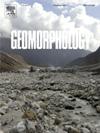晚第四纪北珊瑚三角相对海平面变化与珊瑚礁发育
IF 3.1
2区 地球科学
Q2 GEOGRAPHY, PHYSICAL
引用次数: 0
摘要
菲律宾位于珊瑚三角的顶端,周围环绕着现代和化石珊瑚礁,保存着第四纪相对海平面变化和构造变形的宝贵记录。本研究对吕宋岛西部博利诺角晚更新世珊瑚礁梯田的形成提出了新的解释,为了解珊瑚三角北部的海平面历史、珊瑚礁发育和构造隆起提供了新的见解。综合高分辨率形态分析、新的地质年代学数据和珊瑚礁地层数值模型,我们描绘了9个不同的珊瑚礁梯田。最低的阶地(平均海平面以上~ 4米)可以追溯到全新世中期,而复制现代阶地形态的珊瑚礁模拟将最高的阶地(~ 155米)限制在海洋同位素阶段(MIS) 5e,表明波利诺角的长期隆升速率为1.17±0.03毫米/年。我们提出了一个形态-年代学框架,其中晚更新世桌型礁在缓坡基底上发育并逐渐隆起,导致连续的边缘礁梯田。这种高隆升,加上观测到的倾斜和变形模式,提供了令人信服的证据,表明吕宋岛下方的斯卡伯勒海山链的俯冲作用对马尼拉俯冲带的局部弧前变形起主要控制作用。这项工作为了解北珊瑚三角第四纪CRT的发展提供了一个关键的数据集,并揭示了与俯冲相关的过程如何塑造了该地区的海平面和珊瑚礁记录。本文章由计算机程序翻译,如有差异,请以英文原文为准。
Relative sea-level changes and reef development in the northern Coral Triangle during the late Quaternary
The Philippines, situated at the apex of the Coral Triangle, is fringed by both modern and fossil coral reefs that preserve valuable records of Quaternary relative sea-level changes and tectonic deformation. This study presents a new interpretation of the formation of the Late Pleistocene coral reef terraces at Cape Bolinao in western Luzon, offering insights into sea-level history, reef development, and tectonic uplift within the northern Coral Triangle. Integrating high-resolution morphological analysis, new geochronological data, and reef stratigraphic numerical models, we delineate nine distinct reef terraces. The lowest terrace (∼4 m above mean sea level) dates to the mid-Holocene, while reef simulations replicating present-day terrace morphology constrain the highest terrace (∼155 m amsl) to Marine Isotope Stage (MIS) 5e, indicating a long-term uplift rate of 1.17 ± 0.03 mm/yr for Cape Bolinao. We propose a morpho-chronologic framework wherein a Late Pleistocene table reef developed on a gently sloping substrate and was progressively uplifted, leading to successive fringing reef terraces. This high uplift, coupled with observed tilting and deformation patterns, provides compelling evidence that subduction of the Scarborough Seamount Chain beneath Luzon Island exerts a primary control on localized forearc deformation along the Manila Subduction Zone. This work offers a key dataset for understanding Quaternary CRT development in the northern Coral Triangle and sheds light on how subduction-related processes have shaped the region's sea-level and coral reef records.
求助全文
通过发布文献求助,成功后即可免费获取论文全文。
去求助
来源期刊

Geomorphology
地学-地球科学综合
CiteScore
8.00
自引率
10.30%
发文量
309
审稿时长
3.4 months
期刊介绍:
Our journal''s scope includes geomorphic themes of: tectonics and regional structure; glacial processes and landforms; fluvial sequences, Quaternary environmental change and dating; fluvial processes and landforms; mass movement, slopes and periglacial processes; hillslopes and soil erosion; weathering, karst and soils; aeolian processes and landforms, coastal dunes and arid environments; coastal and marine processes, estuaries and lakes; modelling, theoretical and quantitative geomorphology; DEM, GIS and remote sensing methods and applications; hazards, applied and planetary geomorphology; and volcanics.
 求助内容:
求助内容: 应助结果提醒方式:
应助结果提醒方式:


